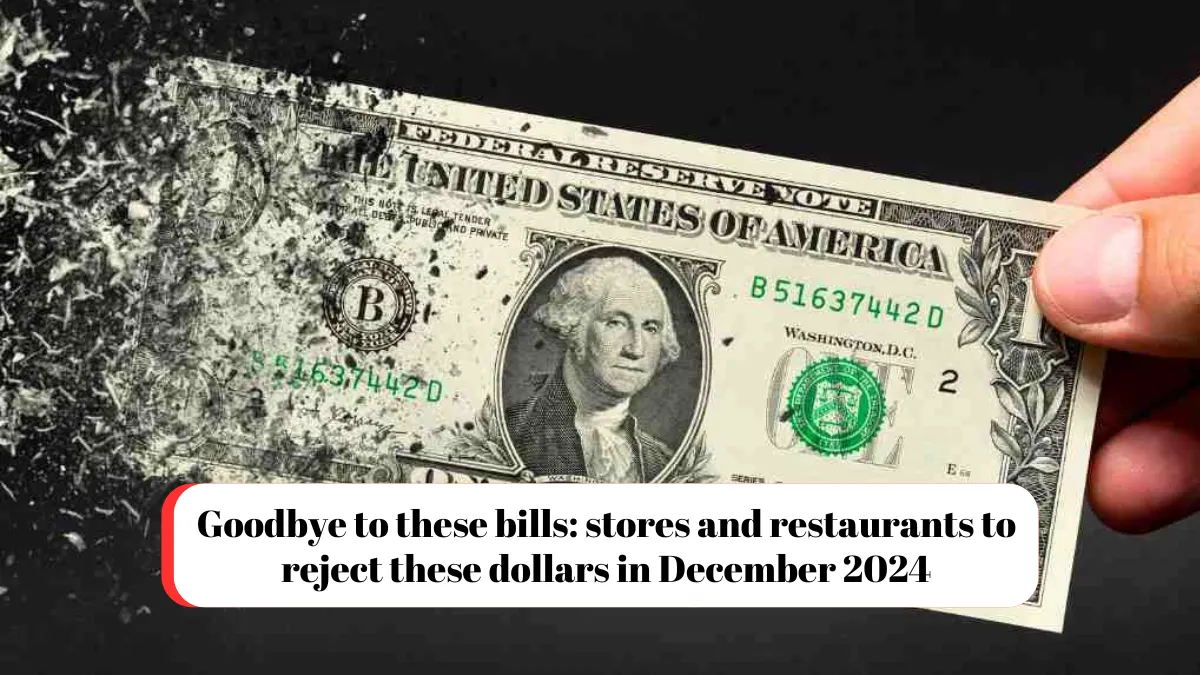As December 2024 approaches, changes in currency policies are set to impact how stores and restaurants handle certain U.S. dollar bills. Under new regulations, businesses will begin rejecting “mutilated” bills to improve the security and integrity of the monetary system. These damaged bills, often resulting from fire, improper handling, or natural wear, are now flagged as unacceptable in many transactions. The policy, backed by the Bureau of Engraving and Printing and the Federal Reserve, requires that businesses strictly adhere to these guidelines.
If you’ve been holding onto worn-out dollar bills, it’s essential to understand these updates and know what steps to take to redeem them. In this blog, we’ll explore the reasons behind the policy shift, how to identify mutilated bills, and what you should do if your currency is no longer accepted. Stay informed to avoid surprises at the checkout counter!
To strengthen the security of the U.S. monetary system, the Bureau of Engraving and Printing, in collaboration with the Secret Service and the Advanced Counterfeit Deterrence (ACD) Steering Committee, implemented a new policy starting in October. This policy mandates that U.S. retailers, businesses, financial institutions, and ATMs refuse dollar bills that are categorized as “mutilated.”
The Federal Reserve issues seven denominations of U.S. currency: $1, $2, $5, $10, $20, $50, and $100. Although higher denominations such as $500, $1,000, and $10,000 bills are no longer in production, they are still considered legal tender and can be found in circulation. However, under the updated guidelines, these larger bills, like all other denominations, will now be refused if classified as “mutilated.”
How to Identify a “Mutilated” Dollar Bill
The Federal Reserve defines “mutilated” banknotes as those damaged by fire, improper handling, or natural wear, such as deterioration from burial. Common signs of mutilation include severe cuts, torn edges, or noticeable discoloration.
What to Do with “Mutilated” Dollar Bills
If you have a mutilated bill, you’ll need to contact the Bureau of Engraving and Printing (BEP) and file a mutilated currency claim. The BEP offers a detailed step-by-step process for redeeming such currency.
A representative from the Federal Reserve explains, “The BEP will analyze the note using specialized tools to verify its authenticity and determine its full value. Once the evaluation is complete, they can issue a reimbursement check to the consumer.”
When Will the Redesigned Bills Be Released?
In an effort to strengthen currency security, the Federal Reserve is preparing to introduce updated designs for the $5, $20, $50, and $100 bills.
The redesigned $50 bill is set to be released in 2028, followed by the $20 bill in 2030. The updated $5 bill is anticipated to roll out between 2032 and 2035, while the redesigned $100 bill is expected to debut between 2034 and 2038.
How to Spot a Counterfeit Banknote
Experts suggest checking the following features to verify the authenticity of a dollar bill:
- Light-Resistant Security Thread: Look for a security thread embedded in the bill with “USA” and the bill’s denomination clearly printed.
- 3D Security Ribbon: Tilt the bill to observe the ribbon, which creates a moving effect as the design shifts.
- Color-Changing Ink: Check the lower right corner for ink that changes color when you tilt the bill.
- Watermark: Hold the bill up to the light to reveal a watermark matching the portrait on the bill.
- Microprints: Inspect the edges and design for tiny text, often undetectable to the naked eye.
- Raised Printing: Feel the surface for embossed textures, especially on the portrait and numerical values.
Conclusion
As stores and restaurants begin rejecting mutilated dollar bills in December 2024, it’s important to stay proactive about checking your currency. By understanding what qualifies as “mutilated” and following the steps to redeem damaged bills, you can ensure your money retains its value.
This policy aims to maintain the security of the U.S. monetary system while protecting businesses and consumers from counterfeit risks. Don’t let worn-out bills catch you off guard take action today to safeguard your finances!
FAQs
1. What is a mutilated bill?
A mutilated bill is currency that has been damaged by fire, improper handling, or natural wear, such as discoloration, cuts, or torn edges.
2. When does the new policy take effect?
The policy requiring businesses to reject mutilated bills begins in December 2024.
3. How can I exchange mutilated bills?
You can redeem damaged bills by filing a claim with the Bureau of Engraving and Printing, which evaluates and reimburses their value.
4. Why are mutilated bills being rejected?
This measure enhances the security and integrity of the U.S. monetary system and reduces counterfeit risks.

